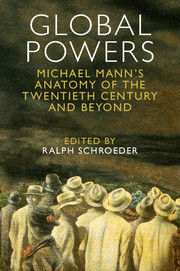Book contents
- Frontmatter
- Contents
- List of contributors
- 1 Introduction
- Part I Theory and history
- Part II Political, economic, military and ideological questions
- Part III American exceptionalism
- Part IV Empire
- 12 Mann and the problem of empire
- 13 Hegemonic power during the Cold War and beyond
- 14 The last empire? American power, liberalism, and world order
- Part V Response
- Index
- References
13 - Hegemonic power during the Cold War and beyond
from Part IV - Empire
Published online by Cambridge University Press: 05 April 2016
- Frontmatter
- Contents
- List of contributors
- 1 Introduction
- Part I Theory and history
- Part II Political, economic, military and ideological questions
- Part III American exceptionalism
- Part IV Empire
- 12 Mann and the problem of empire
- 13 Hegemonic power during the Cold War and beyond
- 14 The last empire? American power, liberalism, and world order
- Part V Response
- Index
- References
Summary
Michael Mann's work has stood at the centre of debates among historical sociologists and historians ever since the first volume of his magnificent Sources of Social Power appeared in 1986. Although I have far too often failed to make explicit reference to it, Mann's writing has deeply influenced my own work, both in terms of orientation and explanations. With the publication of Volumes 3 and 4 in 2012, Mann has completed the best synthesis yet of concepts of power and their uses through history. It is a superb achievement, because Volume 4, which I will discuss in this chapter, caps a series of books that are stimulating, thorough and exceptionally useful for both social scientists and historians.
I am particularly impressed by how Mann's approaches develop throughout the four volumes and, I suppose, the almost thirty years of work that they encompass. Although the basic preoccupations remain the same, as do the primary definitions of social power, the focus expands massively in the final two volumes. They move away – sometimes quite dramatically – from the Eurocentrism that Mann was accused of holding in the two first volumes. And they become deeper and more positioned in an empirical sense: While the two first volumes took the discussion through two millennia, the final two deal with what could be called the (very) long twentieth century, from the 1870s to 2010, or thereabouts.
As a historian of contemporary international affairs, I appreciate the increased depth that comes with Mann's twentieth-century focus. I also very much agree with him that it makes sense to speak of a long twentieth century, one that starts with the great recession of the 1870s and ends with the great recession of the 2010s, rather than the short twentieth century from the outbreak of the First World War to the end of the Cold War, which the great historian Eric Hobsbawm among others present. This is not economic determinism but a serious attempt at getting to grips with the impact that increasingly rapid economic change has had on people's lives and therefore on their concepts of what constitutes social power.
- Type
- Chapter
- Information
- Global PowersMichael Mann's Anatomy of the Twentieth Century and Beyond, pp. 246 - 255Publisher: Cambridge University PressPrint publication year: 2016

